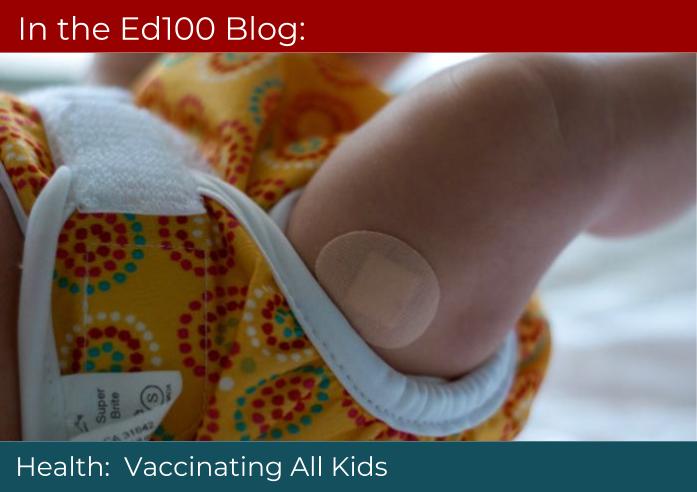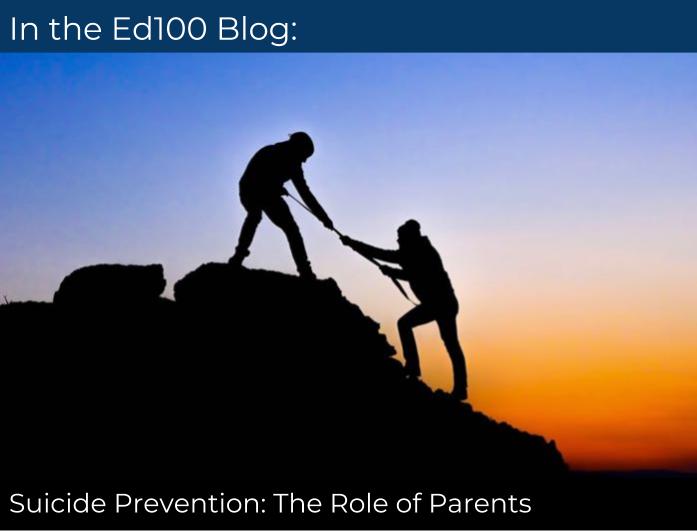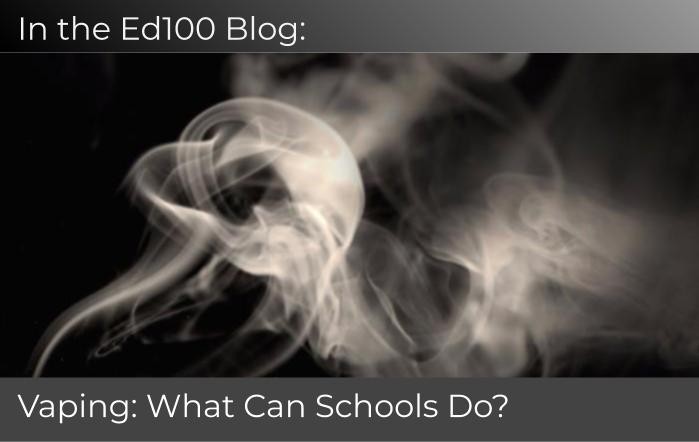
Students learn when they are well. When they aren't well, well…
In This Lesson

How does the school lunch program work?
Are obesity rates in schools getting better or worse?
Does the soda tax work?
What do school nurses do?
How many school nurses are there?
What is a school wellness policy?
What does sex education teach?
Are vaccinations required to attend school?
Which vaccinations do schools require?
Can I opt out of vaccinating my child?
What do schools teach in PE?
Do kids get enough exercise at school?
Why is sleep important for students?
How much sleep do kids need?
Can schools teach mental health?
Can schools help prevent suicide?
Can schools prevent vaping?
▶ Watch the video summary
★ Discussion Guide.
Learning is mental work. It requires presence and concentration, and a lot of things can get in the way. This lesson summarizes many of the ways that health plays a role in school, and vice versa.
Why do schools provide free lunch?
Children cannot concentrate when they are hungry. Food aid began at scale in cities and states during the Great Depression era — it is one of the oldest and most basic interventions in public school systems. Over the years, the National School Lunch Program (authorized in 1946) has been expanded and modified multiple times. Free school meals in California used to be provided only to students who could document that their family was low-income, a cumbersome process that many found humiliating. Beginning in 2022-23, all California public schools, charter schools, and county offices of education were required to provide universal meals. Every student is eligible for free breakfast and lunch daily, regardless of household income.
Many Americans do not eat well. Unhealthy diet, combined with a lack of exercise, contributes to obesity, which has long-term health implications. Rates of obesity in all states have risen over the long term, though less so in California. Boys are more likely to have obesity than girls.
| Milestones in California nutrition policy | |
|---|---|
| 2004 | Banned sales of sugary beverages on school grounds |
| 2008 | Limited calories and fats in school snacks |
| 2008 | Created the Fresh Fruit and Vegetable Program, a supplement to the nutrition programs supported by the federal and state government |
| 2013 | Research confirmed health impact of soda bans |
| 2022-23 | California becomes first state to provide free meals to all students. |
Child nutrition in California is overseen by the State Board of Education through the Child Nutrition Advisory Council (CNAC). Non-government organizations that work to improve child nutrition include Nourish California. During the pandemic, school food services scrambled to adapt. Although the work of serving food is thoroughly local, the money for it has long been mostly driven by federal funding. Historically, school meals were often unappealing. California First Partner, Jennifer Siebel Newsom, has been a forceful advocate for investing state resources in healthy and appetizing school meals, especially through farm-to-school and farm-to-fork programs.
Do schools have nurses?
Budget cuts have had a severe impact on the ability of schools to hire nurses. School nurses — if you have them — take care of a lot more than cuts and scrapes. They administer medications and vaccines, provide health counseling, support school wellness programs, and make health referrals.
The Robert Wood Johnson Foundation warns that the lack of nurses weakens school health services and puts children at risk. In every school, some children suffer from life-threatening conditions and diseases such as diabetes, seizures, asthma, bleeding disorders, mental health problems, and severe allergies. Medical advances have rendered many of these conditions treatable or manageable, but they do not manage or treat themselves.
As of 2024, there was no known reliable data about access to school nurses in California. The best available data were from 2019, when California badly lagged behind the nation in school nurses according to KidsData.org, with 2,410 children per school nurse. The National Association of School Nurses recommends a ratio of 750:1 for well children and 225:1 for student populations with special needs.
Children with acute health care needs may require even more help to remain in school. School Health Services for Children With Special Health Care Needs in California, a report from PACE, points out the challenges facing our children and our schools, such as this eye-opener:
“In the absence of nurses, a range of school personnel are being called on to provide health services, such as administering medication, treating life-threatening allergic reactions, performing gastrostomy tube feeding, injecting insulin, suctioning tracheostomies, and providing urinary catheterization.”
School-based health care
Most children receive health care through whatever insurance their family can afford, which for many families is little or nothing. Health services and school services operate separately, but it is not a church-and-state issue. Schools already play a major role in student health through food aid and vaccination. According to a major study led by Columbia University economics professor Randall Reback, schools could play a significant role in basic health screening, at an incremental annual cost of about $100 per student [in 2018 dollars].
Schools would seem an obvious place to offer screening and basic care, but fewer than 20% of elementary schools in California offer health services for children.
Medicaid funding to support school-based investments is available, Reback notes, but school districts and county health offices rarely coordinate their efforts to take advantage of it. As of this writing in December 2024, the freshest data available (from the California School Based Health Alliance in 2021) identified fewer than 300 school-based health centers in the whole state.
There is no fundamental barrier blocking school districts from including student health in their mission. School districts have the authority to spend on school-based health programs if they want to.
What is the role of schools in vaccinations?
Vaccinations are a cornerstone of public health in California, which requires vaccinations for all students with very few exceptions. Prior to 2016, the law had allowed families to cite personal beliefs to opt out of vaccinations, a policy that led to outbreaks. The COVID-19 pandemic increased public awareness of vaccination policy, further amplified in late 2024 by the nomination of Robert F. Kennedy Jr. to lead the nation's health system. The Centers for Disease Control tracks disease outbreaks.
Certain exemptions are still allowed for a home-based private school or an independent study program with no classroom-based instruction. The California Department of Health provides a website, aptly titled Shots for School, that enables you to check the historical immunization rate at your school.
California's vaccination requirements protect students from school-based outbreaks of the following deadly and disfiguring diseases: Diphtheria, Pertussis, Tetanus, Polio, Measles, Mumps, Rubella, Hepatitis B, and Chickenpox. For additional information about vaccinations in California schools, including a map that estimates your community's vulnerability to outbreaks, see this blog post.
Physical activity and "P.E."
California requires physical education (P.E.) for virtually every child virtually every day, but most children do not get the daily physical activity they need.
According to the Centers for Disease Control and Prevention, physical inactivity is consistently linked to poor grades and lowered educational attainment. The Centers for Disease Control provides school health guidelines to promote healthy eating and physical activity.
P.E. classes aren't just for running around. For more about the role of P.E. in education, see Ed100 Lesson 6.9.
Sex education
Most people agree that schools need to teach sex ed. But they don't necessarily agree about what sex education should include, what the goals of sex ed programs should be, and whether specific programs can achieve those goals.
In 2015, the California legislature updated its policies for sex education and HIV/STD prevention. In doing so, it significantly clarified what schools are obligated to teach. The California Healthy Youth Act requires public schools to provide all students in grades 7-12 with age-appropriate sexual health education that is "comprehensive and medically accurate," meaning that it includes content about human development, sexuality, pregnancy, contraception, and sexually transmitted infections, including HIV. This definition leaves plenty of wiggle room for big variations among schools because the minimum legally required "dosage" of sex ed is just one class session in middle school (grades 7-9) and another in high school (grades 10-12).
For more about sex education in California, have a look at the Ed100 blog post on the subject. The post explores how California schools are dealing with puberty education, teen pregnancy, sexual consent, and other topics.
Lead toxicity and other environmental risks
Health issues go far beyond a school nurse, healthy meals, and physical activity. They include indoor air quality, asthma management, and sun safety measures at school.
Lead is a sneaky toxin. If you see peeling paint, suspect the worst. You shouldn't assume that water at your school is safe, either. California regulations generally require that schools have at least one drinking fountain for every 150 students. In 2013, EdSource exposed data about lead in school drinking fountains across the state. By 2019, hundreds of schools had tested their taps, but gaps remained. EdSource updated its map of lead in school drinking fountains again in 2024.
Sleep!
Compelling research confirms the educational value of sleep. Children need 8.5 to 9.5 hours of it, and they learn poorly when they are fatigued.
For decades, school calendars and schedules were set up in a way that short-changed everyone's sleep. Schedules are generally under the local control of school districts, but in practice, changing them is extraordinarily difficult.
In 2019, partly in response to persistent advocacy by the California State PTA, California enacted laws that forced the issue by specifying how early schools may start. Beginning with the 2022-23 school year, middle schools were required to begin no earlier than 8:00 am, and high schools no earlier than 8:30 am. This was a significant policy change, requiring perhaps 90% of California schools serving those grade levels to revamp their schedule. The transition period ended up coinciding with the pandemic — it was the least of the changes that schools had to deal with!
As an unanticipated benefit of the change, parents got more sleep, too.
Mental health
Aside from parents and family, teachers and other faculty are in the best position to notice mental health issues in children and take supportive action, if they know how.
Anxiety and depression are common maladies for adolescents, especially girls.
Not all childhoods are happy. Some children come to school with symptoms of trauma, and few schools prepare their faculty to offer the help children need. Untreated mental health problems can completely derail learning… or worse. Suicide is the second leading cause of death for adolescents, a topic we explore in greater depth in the Ed100 blog.
Cannabis, vaping and drugs
Many life habits are formed in youth. Unfortunately, young people don't always make healthy choices.
The good news is that long-term trends in this area have been mostly positive for the last several decades. Since 1975, the National Institute on Drug Abuse (NIDA) at the National Institutes of Health has measured drug and alcohol use and related attitudes among adolescent students nationwide through a huge annual study called Monitoring the Future. Over time, teen usage rates of many very dangerous drugs have been trending downward. During the stay-at-home pandemic year of 2021, the rate dropped sharply.
The bad news is that some of these trends seem to be reversing. Teen smoking has largely been replaced with vaping, which is cheaper and stealthier than cigarettes, but every bit as addictive. The legalization of cannabis products in California for adults 21 and older changed public attitudes about the drug and its derivatives, and made access easier for teens and children. The NIH cautions that cannabis has real risks.
Next Steps
All school districts that participate in the National School Lunch Program are required to have a school wellness policy developed with community input. These policies (see example) set goals for nutrition as well as physical activity and other school-based activities. If you are trying to boost wellness in your school, reviewing this policy can be a place to start.
Updated December 2024
CHAPTER 2:
Students...
-
Students...
Overview of Chapter 2 -
Diversity
The Changing Face of America's Students -
Poverty and Race
How Do Students' Backgrounds Affect Their School Performance? -
Health and Learning
What Can Schools Do? -
Parents
A Child's First Teacher -
How Does Education Change
Inputs and Outcomes -
Motivation
What Motivates Students? -
Special Needs
Why Not Teach All Kids Alike? -
Child Protection
Intervention and foster care -
Undocumented Students
Education vs. Documentation -
Student Voice
What is the Role of the Student in Education Leadership?
Related
-
History of Education
How have Schools Changed Over Time? -
Poverty and Race
How Do Students' Backgrounds Affect Their School Performance? -
Special Needs
Why Not Teach All Kids Alike? -
Community Schools
Services beyond classwork -
P.E. and Athletics
How does sweat and movement help learning? -
The Federal Government
Small money, big influence
Sharing is caring!
Password Reset
Search all lesson and blog content here.
Login with Email
We will send your Login Link to your email
address. Click on the link and you will be
logged into Ed100. No more passwords to
remember!



















Questions & Comments
To comment or reply, please sign in .
Carol Kocivar May 3, 2025 at 8:02 am
The Trump administration is moving to cancel $1 billion in school mental health grants, saying they reflect the priorities of the previous administration. A new notice said an Education Department review of the programs found they violated the purpose of civil rights law, conflicted with the department’s policy of prioritizing merit and fairness and amounted to an inappropriate use of federal money. Read the article. https://apnews.com/article/school-mental-health-grants-trump-biden-dei-00bec2d96371f023ac56fe3f32f3e92f
Carol Kocivar April 24, 2025 at 12:11 pm
"School districts, charter schools, and county offices of education now are required to provide one free breakfast and one free lunch per school day to any student requesting a meal. Since enactment, the number of meals served and the funds the state has provided for school meals has increased. The state has also provided one‑time Kitchen Infrastructure and Training (KIT) funds to LEAs to implement the universal meal requirements.
Recommend Providing More School Nutrition Funding in the Budget Year. We estimate the state will serve 967 million meals in 2025‑26, or 46 million (5 percent) above the administration’s estimate. Based on our higher estimates, we recommend providing $32 million more than the Governor proposes for school nutrition programs in 2025‑26. This would reflect cost growth more consistent with recent trends in the number of school meals served."
Jeff Camp - Founder October 9, 2023 at 8:17 pm
Carol Kocivar August 24, 2023 at 2:28 pm
https://www.cde.ca.gov/re/mo/cameals.asp
Jeff Camp - Founder September 7, 2022 at 10:23 am
Carol Kocivar August 4, 2022 at 1:29 pm
The state 2022-23 Budget includes $600 million one-time available over three years for school kitchen infrastructure upgrades and equipment, food service employee training, and compensation for work related to serving universal meals using more fresh, minimally processed California-grown foods.
The Budget also includes $100 million one-time to support local educational agency procurement practices for plant-based or restricted diet meals, to procure California-grown or California-produced, sustainably grown, whole or minimally processed foods, including for use in plant-based or restricted-diet meals, or to prepare meals fresh onsite.
Carol Kocivar August 4, 2022 at 1:25 pm
The 2022-23 state Budget includes $596 million to fund universal access to subsidized school meals. It also includes an additional $611.8 million ongoing to augment the state meal reimbursement rate sufficient to maintain meal reimbursement rates beginning in 2022-23.
This higher rate of reimbursement will enable local educational agencies to continue offering higher-quality and more diverse meals for students.
If the federal government extends the waiver that allows for the allocation of higher federal reimbursement rates, any unused state funding for rate increases in 2022-23 would instead be made available for food procurement grants.
Carol Kocivar June 14, 2022 at 12:44 pm
February 8, 2022 - This post provides background on various child nutrition programs and requirements and offers associated assessments and recommendations to the Legislature. https://lao.ca.gov/reports/2022/4519/school-nutrition-020822.pdf
Carol Kocivar November 1, 2021 at 6:05 pm
Selisa Loeza October 22, 2021 at 6:57 pm
Carol Kocivar October 19, 2021 at 12:57 pm
amy su November 5, 2020 at 8:41 pm
Emily Cruz October 29, 2020 at 6:47 pm
Sonya Hendren July 11, 2020 at 1:37 pm
Perhaps when a COVID-19 vaccine is available, districts with school nurses will be able to help quickly vaccinate our student population.
Jeff Camp September 18, 2018 at 12:38 am
Jeff Camp September 18, 2018 at 12:12 am
Carol Kocivar March 3, 2018 at 6:54 pm
30 Remarkable Health Benefits of Sleep (Backed up by Science)
Take a Look!
Robert Crowell May 2, 2018 at 9:18 am
Carol Kocivar December 5, 2017 at 11:18 am
From the Harvard Graduate School of Education:
When the Nurse's Office is a Refuge
The vital, overlooked role of school nurses in combatting student anxiety
https://www.gse.harvard.edu/news/uk/17/11/when-nurses-office-refuge
Carol Kocivar June 20, 2016 at 9:50 am
According to the National School Boards Association:
"....(M)ore than 80 percent of the children who qualify for summer meal programs do not participate. State boards can do two things to expand the reach of summer nutrition programs: They can support the adoption of state mandates for participation, and they can partner with other state organizations to improve community outreach."
http://www.nasbe.org/wp-content/uploads/Hayes-Fobbs_Summer-Nutrition-Final.pdf
Jeff Camp - Founder January 20, 2016 at 11:57 am
Disappointed by Public School October 2, 2015 at 1:03 am
If your school is not providing that, you can contact Don Driscoll JD who is suing the Dept of Ed for not complying with the law and sign on... [email protected]
What has happened with PE, I think, is that there is all this focus on "no child left behind" Pass the tests. So the money is spent on testing and taken away from PE.
At least your school has the breakfast. Our school does not provide breakfast although 5% of our students quality for it. (I know that's not a huge % but no child should be left hungry and could account for a lot of the "adhd" in our classes)
Our school went from a healthy vendor to an unhealthy one that doesn't understand the nutritional regulations.
Jenny N September 28, 2015 at 4:48 pm
Tara Massengill April 18, 2015 at 6:53 pm
Disappointed by Public School October 2, 2015 at 1:11 am
geecookie2011 April 18, 2015 at 7:21 am
I'm not sure how accurate a lot of things that are coming out in school about concerned with obesity but I do know that our children are starving more then ever. When My Granddaughter and also in children her own grade and younger comes home who in her case is very very petite. She is more hungry than before. she is hungry I need you don't want to snack she wants to eat and then later want to eat dinner and she says it's because she is extremely hungry. Due to she have breakfast at 8:20am and then she eat lunch at 12 and still in school for another 3.4 hours afterward. Then come home at 4:pm what to eat then eat dinner the rest of the Family when we all come home at 6:30pm. I find there should be a more concern eating at that time more a risk of obesity because they're not as active as they are doing school hours because they are in school 90% of the Daylight hours.
Also my concern is if this is my granddaughter who most of the time is blessed to have some type of food in the home, I wonder about children who has little to no foods or resources in their home. So what happened to those children, who if they can get a solid meal at school, like a real breakfast and lunch. Who don't get or alittle dinner. I can't help to wonder if my granddaughter comes home hungry. Then what is it like for the students who is not provide a better meals at home. Because what I see in our cafeteria these days look like a snacks, truly not a lunch or breakfast. Especially in low poverty locations, title 1 students who are being funded so that they can have decent meals at school while learning. I have seen that if a child is hungry he or she will not be suitable to properly get a fair quality education just thinking out loud. Ms Cookie G
jenzteam February 27, 2015 at 9:18 am
This is a complete myth since my kids have access to Gatorade (which contains as much sugar and chemicals as soda) and sugared cookies and snacks every single day. I had to battle the school district to disallow my kids from purchasing anything on their "account". I finally stopped paying into the school lunch program and packing lunches in order to control their diets. You DEFINITELY don't see schools selling organic veggies and whole grain foods. It's still pizza, fries, cheeseburgers, chips, and other cheap foods - which they profit from selling. What is most irritating is that the schools still profit from selling these items as "add ups" from the free/reduced lunch program. So again, I can pay $.40 for lunch and $2 for a Gatorade or bottle of water. It's about profits. I have yet to see a salad bar or fresh/steamed vegetables included on the school lunch menu.
As for physical activity, we take care of that in our home. As for the school, my kids tell me they are allowed to "walk" the mile if they want instead of run it. They are not required to meet any standards and both have A+ in PE. Why are we requiring PE for 4 years in CA if there are no expectations to perform?
Disappointed by Public School October 2, 2015 at 1:11 am
Your school is NOT allowed to sell unhealthy foods/drinks by law for profit, until after school. They are violating the regulations.
here are the requirements..
http://publichealthadvocacy.org/_PDFs/SB12Summary.pdf
You can file a report with the DOE by emailing or calling Shirley Rhodes 916-323-8521
Brandi Galasso February 9, 2015 at 10:44 am
Carol Kocivar - Ed100 October 26, 2014 at 3:40 pm
Immunization and Health Checkup - CalEdFacts
http://www.cde.ca.gov/ls/he/hn/cefimmunization.asp
Want to see where there have been preventable disease outbreaks?
Here’s a link to a map that provides detail for California, US and the world. http://www.cfr.org/interactives/GH_Vaccine_Map/#map
Jeff Camp - Founder October 2, 2014 at 6:40 pm
Richard Rothstein March 14, 2011 at 7:45 am
Overall, lower-class children are in poorer health.
-> Those with vision problems have difficulty reading. In the United States, 50 percent of poor children have vision impairment that interferes with academic work, twice the normal rate. Lower-class children may be more likely to have vision problems because of less adequate prenatal development than middle-class children whose pregnant mothers had better medical care and nutrition. Visual deficits also arise from disadvantaged children being placed in inexpensive low-quality child care settings where they watch too much television, activity that does not develop hand-eye coordination and depth perception - 42 percent of black fourth graders watch six hours or more of television a day, compared to 13 percent of whites. Middle-class children more likely have manipulative toys that develop such coordination. A longitudinal study of entering kindergarteners reveals that fine motor skill development at age 5 is a stronger predictor of later mathematics and reading performance than is kindergartners' pre-literacy knowledge (of the alphabet, of counting numbers, of phonemes).
-> Lower-class children also have more hearing difficulties, possibly because of untreated ear infections that occur in children whose overall health is less robust. Ear infections are easily treatable for children with access to regular pediatric care. But lower-class children with less access to such treatment are less attentive, on average, in school.
Children without dental care have more toothaches; untreated cavities are nearly three times as prevalent among poor as among middle-class children. Although only some cavities produce toothaches, children with toothaches pay less attention in class and are more distracted during tests, on average.
Children who live in older buildings have more lead dust exposure that harms cognitive functioning and behavior. High lead levels also contribute to hearing loss. Low-income children have dangerously high blood lead levels at five times the rate of middle-class children.
->Lower-class children, particularly those who live in densely populated city neighborhoods, are also more likely to contract asthma – the asthma rate is substantially higher for urban children, for those whose families are on welfare, and for those from single parent or poor families. Asthma is provoked partly from breathing fumes from low-grade heating oil, diesel trucks, and buses (school buses idling at schools are a serious problem); excessive dust and allergic reactions to mold, cockroaches, and secondhand smoke also contribute. In neighborhoods with high asthma rates, children suffering from the disease are more likely to live in homes where adults smoke.
Asthma keeps children awake at night. If attending school, asthmatics are more likely to be drowsy and inattentive, more irritable and with more behavioral problems, and more likely to refrain from exercise and thus be less physically fit. Middle-class children typically get treatment for symptoms, while low-income children get treatment less often. Asthma has become the biggest cause of chronic school absence, with sufferers from low-income families more likely to miss school than those from middle-class families.
->Youngsters whose mothers consumed alcohol during pregnancy have more difficulty with academic subjects, are less able to focus attention, have poorer memory skills, less ability to reason, lower I.Q.’s, less social competence and more aggression in the classroom. In adolescence, these children continue to have difficulty learning. Fetal alcohol syndrome, a collection of the most severe cognitive, physical and behavioral difficulties experienced by children of prenatal drinkers, is ten times more frequent for low-income black than for middle-class white children.
->Smoking in pregnancy also contributes to lower achievement. Children of mothers who smoked prenatally do more poorly on cognitive tests, and their language develops more poorly. They have more serious behavioral problems, more h